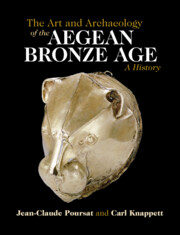Book contents
- The Art and Archaeology of the Aegean Bronze Age
- The Art and Archaeology of the Aegean Bronze Age
- Copyright page
- Contents
- Figures
- Introduction
- Part I Aegean Neolithic Art
- Part II The Art of the Aegean Early Bronze Age
- Part III Aegean Art in the Cretan First Palace Period
- Part IV Aegean Art in the Second Palace Period
- Part V Aegean Art in the Cretan Second Palace Period
- Part VI Aegean Art in the Final Palatial Period of Knossos
- Chapter 33 Artworks in Context
- Chapter 34 Architecture
- Chapter 35 The Frescoes
- Chapter 36 Metalwork, Jewellery, and Various Ornaments
- Chapter 37 Creto-Mycenaean Glyptic in LM II/LH IIB–IIIA1
- Chapter 38 Other Relief Arts
- Chapter 39 Artworks in the Round
- Chapter 40 LM II/LH IIB–IIIA1 Pottery
- Part VII Aegean Art of the Mainland Mycenaean Palatial Period
- Part VIII Aegean Art at the End of the Bronze Age
- Afterword Aegean Art Through Forgers’ Eyes
- References
- Index
- Plate Section (PDF Only)
- References
Chapter 33 - Artworks in Context
The Historical Framework
from Part VI - Aegean Art in the Final Palatial Period of Knossos
Published online by Cambridge University Press: 19 May 2022
- The Art and Archaeology of the Aegean Bronze Age
- The Art and Archaeology of the Aegean Bronze Age
- Copyright page
- Contents
- Figures
- Introduction
- Part I Aegean Neolithic Art
- Part II The Art of the Aegean Early Bronze Age
- Part III Aegean Art in the Cretan First Palace Period
- Part IV Aegean Art in the Second Palace Period
- Part V Aegean Art in the Cretan Second Palace Period
- Part VI Aegean Art in the Final Palatial Period of Knossos
- Chapter 33 Artworks in Context
- Chapter 34 Architecture
- Chapter 35 The Frescoes
- Chapter 36 Metalwork, Jewellery, and Various Ornaments
- Chapter 37 Creto-Mycenaean Glyptic in LM II/LH IIB–IIIA1
- Chapter 38 Other Relief Arts
- Chapter 39 Artworks in the Round
- Chapter 40 LM II/LH IIB–IIIA1 Pottery
- Part VII Aegean Art of the Mainland Mycenaean Palatial Period
- Part VIII Aegean Art at the End of the Bronze Age
- Afterword Aegean Art Through Forgers’ Eyes
- References
- Index
- Plate Section (PDF Only)
- References
Summary
The period of around a century that begins c.1450 bc with the destruction of the Second Palaces on Crete is a pivotal time when the foundations of a new palatial civilisation develop on the mainland. It encompasses the ceramic phases Late Helladic (LH) IIB (roughly contemporary with Late Minoan (LM) II) (C. Hershenson, in Mendoni and Mazarakis-Ainian 1998, 161–8), LH/LM IIIA1, and the very beginning of LH/LM IIIA2. Fairly well delimited on Crete by the 1450 bc destructions and a major destruction of the final palace of Knossos c.1370 bc, it is harder to define precisely on the mainland where ceramic phases follow each other without visible break on most sites. Yet it is a new period for Mycenaean civilisation, during which artistic changes coincide with rapid social development.
- Type
- Chapter
- Information
- The Art and Archaeology of the Aegean Bronze AgeA History, pp. 329 - 333Publisher: Cambridge University PressPrint publication year: 2022

